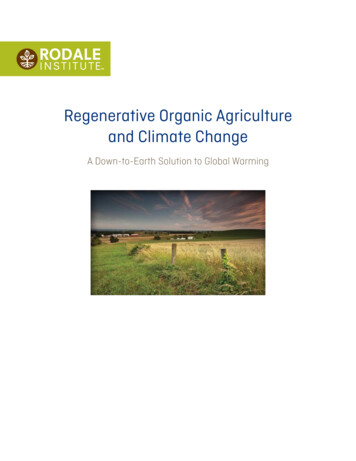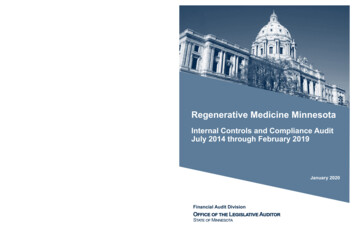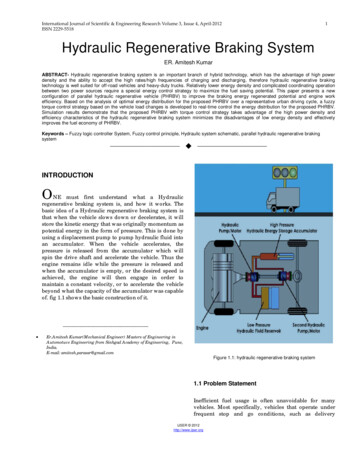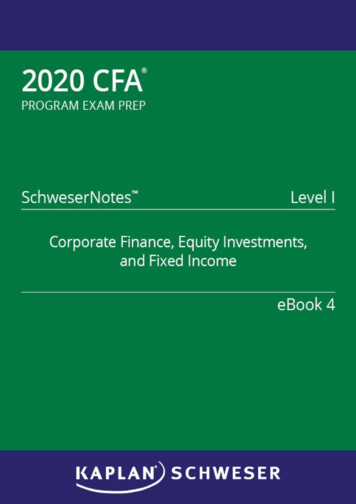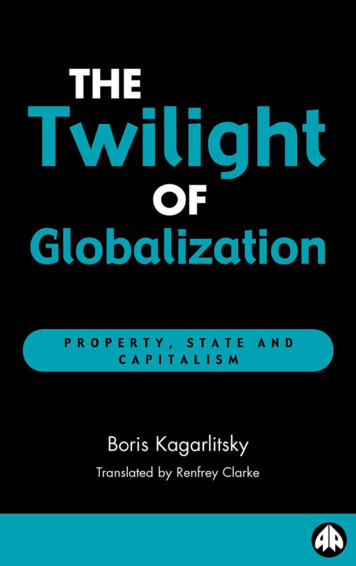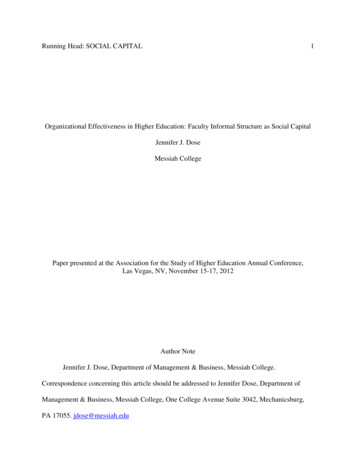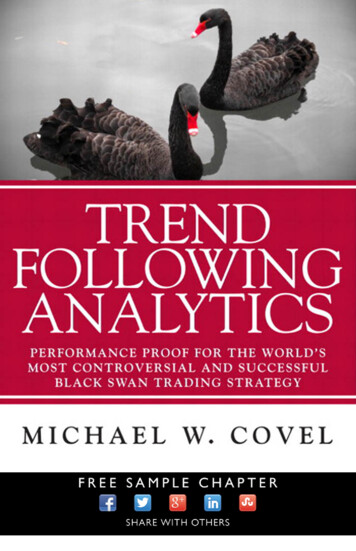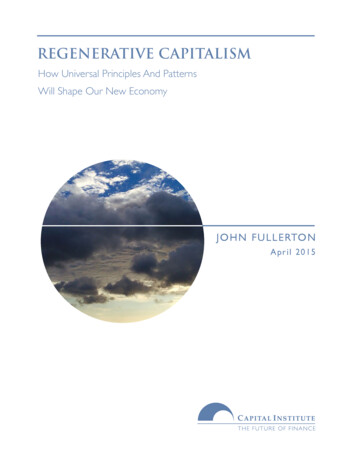
Transcription
REGENERATIVE CAPITALISMHow Universal Principles And PatternsWill Shape Our New EconomyJ OH N F U L L E RTONApril 2015
TABLE OF CONTENTSACKNOWLEDGEMENTS. 1PROLOGUE. 2EXECUTIVE SUMMARY. 5CHAPTER 1: INTRODUCTION. 14What Comes Next?. 17The Regenerative Hypothesis. 21Today’s Copernican Shift. 24CHAPTER 2: FROM A MECHANISTIC TO A HOLISTIC WORLDVIEW. 27Separate Parts versus Dynamic Wholes. 28Beyond Mere Metaphor: The Empirical Science of Flow. 32Creating Regenerative Economies Using the Laws of a Holistic Universe. 34CHAPTER 3: EIGHT KEY PRINCIPLES OF REGENERATIVE CAPITALISM. 39What is a Regenerative Economy?. 40How Do You Build Regenerative Vitality? – 8 Key Principles. 431. In Right Relationship. 442. Views Wealth Holistically. 503. Innovative, Adaptive, Responsive. 554. Empowered Participation. 585. Honors Community and Place. 626. Edge Effect Abundance. 677. Robust Circulatory Flow. 708. Seeks Balance. 74Rethinking Capitalism. 79CHAPTER 4: REGENERATIVE CAPITALISM EMERGING IN THE REAL WORLD. 82Regenerative Movements in Action . 82Creative Regenerative Projects and Enterprises of the Field Guide. 86Implications for Politics and Public Policy. 91Implications for Finance. 95Measuring and Managing Systemic Health in Complex Webs. 99CHAPTER 5: CREATING A REGENERATIVE CIVILIZATION .106Changing the Dream.109APPENDIX: THE SCIENCE OF ENERGY FLOW NETWORKS.110ABOUT CAPITAL INSTITUTE.116ABOUT THE AUTHOR.117
R E G EN ER AT I VE C A PITA LISM1ACKNOWLEDGEMENTSThis paper is a collaborative effort, and an ongoing work in progress. It is less a new theorythan a rediscovery and synthesis of what is hidden in plain sight. I have tried to organizenumerous insights from valued colleagues who are my teachers, together with my ownthinking informed by my experience in the world of finance, my years of study since leavingthat world, and the wisdom and intuition of the entrepreneurs I have had the privilege ofworking with as an impact investor. Nevertheless, what is presented here is by no means acomplete picture, only a direction.I am indebted to far too many thinkers and practitioners for opening my eyes to the ideasoffered up in this paper than is practical to mention here. My work with Peter Brown, BobNadeau, and other members of the Steering Committee on The Third Millennium Economyproject at Capital Institute has been profoundly impactful. In addition, my understandingof holism and the regenerative paradigm only came together through my engagement firstwith Allan Savory and Jim Howell, and then with Carol Sanford, Bill Reed, Ben Haggard andAnthony Sblendorio. I am also particularly indebted to Sally Goerner for her illumination ofthe empirical foundation of energy flow networks. Her contribution to my understandingand her thoughtful editing of this paper has been invaluable.I would also like to single out Herman Daly, who deserves the Nobel Prize in economics,Gar Alperovitz, Peter Barnes, Janine Benyus, Wendell Berry, Fritjof Capra, Bob Costanza,John Elkington, Paul Hawken, Hazel Henderson, Jessie Henshaw, Tad Homer-Dixon, TimJackson, Wes Jackson, Stuart Kauffman, Marjorie Kelly, Ashok Khosla, David Korten, AmoryLovins, David Orr, Bill Rees, Rich Rosen, John Ralston Saul, Julie Schor, Gus Speth, PavanSukhdev, Woody Tasch, Vanessa Timmer, Peter Victor, Stewart Wallis and Allen White, all ofwhom have contributed more than they are aware. Hunter Lovins has been extraordinarilysupportive, and her work on natural capital and the business case for sustainability isfoundational. And of course there are my intellectual heroes I never had a chance to know,such as Thomas Berry, Kenneth Boulding, Buckminster Fuller, Willis Harman, Jane Jacobs,Dana Meadows, E.F. Schumacher, Jan Smuts, and Rudolph Steiner, to name just a few.Geniuses all, who should be required reading at this pivotal time.Finally, I am most grateful to all of my colleagues, and our network of partners andcollaborators at Capital Institute for their contributions and dedication to our work.John Fullerton, April 2015C O - C R E AT I NG T H E R E G E N E R AT I V E E C ONO MYC A P I TA L I N S T I T U T E
R E G EN ER AT I VE C A PITA LISM2PROLOGUEWhen I resigned from JPMorgan in the spring of 2001 after a nearly 20-year career, I didn’tknow what would come next. What I did know was that I no longer recognized the Morganculture I had once cherished. Furthermore, I had become restless, feeling my career had lostany purpose beyond achieving “success” as defined by Wall Street and my Morgan bosses.The culture I so valued had been defined by J.P. Morgan, Jr. in his testimony to a Senatesubcommittee following the Crash of 1929. There Morgan spoke of the banker’s “code ofprofessional ethics and customs.” He concluded saying that, while the Morgan Bank had mademistakes, those mistakes had been “errors of judgment, and not of principle.”In truth, this principled approach to banking had been in decline for years, a victim of thefierce pressure of competitive capital markets in a deregulated world, where economic brawnincreasingly trumped civility. The recently completed takeover of Morgan by Chase Manhattanmerely put the final nail in the coffin. At the time, Chase was focused on consolidating thebanking industry through acquisition, a “rollup” strategy centered on increasing scale andcutting costs. This process was often brutal, but it worked well. Now, my future would requireanswering to new bosses with a new culture, and my initial impressions sent up red flags.Disillusioned about the direction Wall Street was headed and the loss of the culture I soadmired, I decided to walk away without a clear plan for my future. Then, not long afterresigning, I experienced 9/11 first-hand. My disillusionment merged with despair.What followed was years of searching. I was searching for how to make sense of a worldthat I could no longer explain to my children. At some level, I was also searching for my ownpurpose in it all.This search first opened my eyes to the profound, interlocking crises we are now facing –ecological, economic, and social – including the shocking prospect that we are destroyingthe planet’s ability to support life as we know it. My most startling discovery, however, wasthat the modern scheme of economics and finance – what Wall Street “geniuses” (like me)practiced so well – formed the root cause of these systemic crises. This realization occurredbefore the 2008 financial crisis and exists independent from it. However, that egregiousdisplay of irresponsibility, greed, and fraud further confirmed the reality that Wall Street hadlost its way.C O - C R E AT I NG T H E R E G E N E R AT I V E E C ONO MYC A P I TA L I N S T I T U T E
R E G EN ER AT I VE C A PITA LISM3My struggle to find a credible alternative framework for economics and finance sharpened myinterest in the intellectual and scientific underpinnings of “systemic” or “holistic” approaches. Ibegan by studying how we might apply the lessons of living systems to economic systems.Here my re-education became practical as well as intellectual. Through my impact investment1projects, ranging from values-based banking to holistic rangeland management, I experiencedthe economic benefits of systemic decision-making firsthand. I have since observed thepractical benefits of balanced social, economic, and ecological health demonstrated in morethan 25 stories illuminated in Capital Institute’s Field Guide to Investing in a RegenerativeEconomy.2I then discovered that scientists were turning the rules by which living systems sustainand regenerate themselves into empirical principles of systemic health and development,which applied as much to nonliving systems, including economies, as to ecosystems and livingorganisms. The resulting synthesis produced an unexpected alignment of insights from fieldsranging from physics and biology to sociology and even the core spiritual beliefs common toall the world’s great wisdom traditions. For me, the message became clear:We can — and must — bring our economic theory and practice into alignment with ourlatest understanding of how the universe and our humanity actually work!My practical experience working with real-world regenerative projects and the solid sciencebased theory of regenerative economies presented here have made me confident in boththe promise of Regenerative Capitalism, and the fact that it is already unfolding before oureyes. What remains is the immense challenge to spur a broad awakening to the profoundsocial and economic transition it implies. Recognizing our shared purpose can help sustain theunwavering drive toward the great work that lies ahead.This quest to understand the possibility of regenerative economics ended up answering thequestion of why I left JPMorgan over a decade ago with no knowledge of what my futuremight hold. It also gave new meaning to my 20-year experience witnessing high-finance’s1Impact investing involves investing in projects that harmonize financial, social, and ute.orgC O - C R E AT I NG T H E R E G E N E R AT I V E E C ONO MYC A P I TA L I N S T I T U T E
R E G EN ER AT I VE C A PITA LISM4spectacular rise and alarming descent. Yet my appreciation of how purpose enables us totranscend our differences and find true meaning in our lives came most directly from myfather.A few years before he passed away, I took a three-day trip with my father. The longest oneon-one experience I can recall with my dad, it was a unique opportunity for me to hear himreflect on his life. What struck me was that he kept coming back to the war. My dad hadserved in the Navy in World War II, took part in the Normandy invasion, and later captaineda sub-chaser in the Pacific. The look in his eye as he spoke revealed that, despite the fear, pain,loss, and horror the war had brought, it had also been a deeply meaningful experience for himpersonally. What became clear to me listening over those three precious days was that it wasthe shared, noble purpose of the war – not the sacrifices – that had come to define his life. Hewas, after all, part of the Greatest Generation.Our generation’s challenges and threats are different. We too must overcome our fears. Butwe must also transcend our ideological divides and our false separation from one another andfrom our environment. Climate change, ever-rising inequality, and even the despair that fuelsradical fundamentalism are all symptoms of a deeply flawed economic ideology that requiresthat we shift to a more effective, systemic way of thinking about our next economy. Thatsystemic shift most certainly includes the transformation of the financial system to embrace ameaningful purpose in service of a regenerative world.This is a monumental challenge that holds the promise of uniting our generation in a sharedpurpose. We now have a more rigorous understanding of what makes human networkshealthy – this alone constitutes an amazing opportunity. It is time to act. Our actions, now, willmost certainly define the nobility of our lives and our legacy. This is the Great Work of ourtime.“ And miles to go before I sleep.” – Robert FrostC O - C R E AT I NG T H E R E G E N E R AT I V E E C ONO MYC A P I TA L I N S T I T U T E
R E G EN ER AT I VE C A PITA LISM5EXECUTIVE SUMMARYGlobal threats – from climate change and accelerating inequality, to the financial crisis of2008 – have led an increasing number of thought leaders and policymakers to questionthe long-term viability of today’s dominant form of capitalism3. Even the rise of terrorism isfueled, at least in part, by the repression and exploitation of the economically and politicallydisempowered.At the same time, a multitude of innovators and entrepreneurs around the world areexperimenting with practical ways to reimagine capitalism so that it works for all levels ofsociety, as well as for the planet. In our terms, their common goal is to create a self-organizing,naturally self-maintaining, highly adaptive Regenerative form of capitalism that produces lastingsocial and economic vitality for global civilization as a whole.Over the last two years, Capital Institute has been working with many of these thought leadersand entrepreneurs in a quest to understand what a theoretical framework for regenerativeeconomies would look like, and what conditions and processes contribute to their long-termsystemic health. We also explored how a Regenerative Economy would differ from today’sflawed theory of capitalism, and how it would compare to other New Economy ideas suchas natural capitalism, sustainable capitalism, conscious capitalism, doughnut economics, circulareconomies, sharing economies, steady-state economies, etc.Where today’s mainstream economic debates are usually couched in liberal versusconservative ideology, we felt a much deeper inquiry was required, one that examined theunquestioned assumptions of both the left and the right. For instance, does exponential,undifferentiated economic growth — the still largely unquestioned objective of liberal andconservative economists alike — really define the path to long-term prosperity? Is suchconstantly expanding growth even possible given the already massive scale of today’s globaleconomy and our planet’s finite resources? And, what role does modern finance play withits single-minded pursuit of optimizing returns, in driving the systemic outcomes that areunsustainable?3Language issues surrounding the term “capitalism” are ver y complex today. What we’re calling“today’s dominant form of capitalism” is generally called neoliberalism and the WashingtonConsensus, with heavy influence from the free-market-oriented Chicago School of economicsand the Hayek philosophy. Since the financial crash of 2008, a resurgence of Keynesian andpar ticularly post-Keynesian ideas have pushed back into the mainstream debate, calling for agreater role for the State in regulating free-market capitalism.C O - C R E AT I NG T H E R E G E N E R AT I V E E C ONO MYC A P I TA L I N S T I T U T E
R E G EN ER AT I VE C A PITA LISM6Let me say up front very clearly: Regenerative economics is not about the well-worn debateof capitalism versus socialism. Both systems, even if flawlessly executed, are unsustainable.Nor is it a proposal for incremental change to a system that is fundamentally sound but for afew glitches.What I am saying is that the history of economic theory is not over with Keynes and Hayek(or Minsky and Friedman), leaving their disciples to squabble on the public square indefinitelyinto the future. In fact, recent events including the 2008 financial collapse, the (under)statement by pre-eminent economist Sir Nicholas Stern that climate change represents thelargest market failure in the history of capitalism, and the phenomenon surrounding therelease of Thomas Piketty’s Wealth in the Twenty First Century, collectively signal the end of thebeginning. Regenerative Capitalism aims to contribute to the vital shift in thinking that is aprecondition for us to embark on what follows the beginning.What is Regenerative Capitalism? We began our quest for deeper explanations withbiomimicry4 in mind. That is, since living systems are both sustainable and regenerative overlong periods of time, we began exploring whether following nature’s rules of health anddevelopment might lead to sustainably vibrant economies as well. But, the more we exploredthis thesis, the bigger and more diverse the picture became. We discovered that what we call“systemic” or “holistic” approaches could be seen in work ranging from Jane Jacobs’ on-theground urban observations in Death and Life of the Great American Cities, to Herman Daly’stheories of steady-state economics. Indeed, close examination showed holistic conceptsemerging in almost every field imaginable, from agriculture and healthcare to monetarysystems, urban planning, and network-centric technology.This broad form of holism grew out of the observation that everything in the universe isorganized into “systems” whose interlinked parts work together in some larger process orpattern. The incredible range of holistic work we were encountering reflected a commonquest to understand the reasons for such “systemic behavior,” a pursuit that stretched fromthe sacred geometries of the ancient Greeks to the study of ecosystems and social mediatoday.4“Biomimicr y is an approach to innovation that seeks sustainable solutions to human challengesby emulating nature’s time-tested patterns and strategies.” – see the Biomimicr y Institute, http://biomimicr y.org/what-is-biomimicr yC O - C R E AT I NG T H E R E G E N E R AT I V E E C ONO MYC A P I TA L I N S T I T U T E
R E G EN ER AT I VE C A PITA LISM7This quest’s most important discovery was that universal principles and patterns of systemichealth and development actually do exist, and are known to guide behavior in: living systemsfrom bacteria to human beings; nonliving systems from hurricanes to transportation systemsand the Internet; and societal systems including monetary systems5 and yes, economies.Furthermore, though such holistic thinking is sometimes viewed as the province of mystics orhippies, we soon discovered that new fields of science were turning this core holistic discoveryinto rigorous explanations of how universal dynamics – such as energy and pressure – shapehealth and development in real-world systems of all kinds. The resulting science of “flowsystems” not only provides the empirical theory and precise measures of systemic health weneed to guide our steps, it also grounds long-standing observations about the importance ofcirculation, balance, and even of ideals such as justice and fair play.In short, the study of systemic behavior is now producing a very practical, rigorous, and evencommonsense new picture of how the world works. We believe the combination of practicalexperience gleaned from investing in and observing regenerative New Economy experimentsrising up worldwide, anchored in today’s rigorous form of holism, can show us how to turntoday’s lopsided (and unsustainable) form of capitalism into an integrated network of balanced,vibrant, and regenerative economies, all serving systemic health within their own unique contexts.Our goal here is to illuminate this new synthesis and to craft a coherent narrative around it sothat it may be applied to defuse today’s global threats, particularly those arising from outdatedand at-times-misguided beliefs in business, finance, and economics.The implications for how we think about organizing and managing our capitalist system areprofound. Some will reject this framework as idealistic; others will say it does not go farenough with reform. Our belief is that this framework can bridge between the current worldand the one that is in the process of emerging in a way that is both realistic and necessarilyfundamental. This paper aims to make a contribution to the learning journey that lies aheadfor policymakers, as well as progressive leaders in business and finance.5Lietaer, B., Arnsperger, C ., Goerner, S., & Brunnhuber, S. 2012. Money and Sustainability, The MissingLink. Devon, UK: Triarchy Press.C O - C R E AT I NG T H E R E G E N E R AT I V E E C ONO MYC A P I TA L I N S T I T U T E
R E G EN ER AT I VE C A PITA LISM8TOWARDS A REGENERATIVE ECONOMYOur Regenerative story starts with a single core idea:The universal patterns and principles the cosmos uses to build stable, healthy, andsustainable systems throughout the real world can and must be used as a model foreconomic-system design.We then distill our research into eight key, interconnected principles that underlie systemichealth (see Chapter 3):1. In Right Relationship6 – Humanity is an integral part of an interconnected web of life inwhich there is no real separation between “us” and “it.” The scale of the human economymatters in relation to the biosphere in which it is embedded. What is more, we are allconnected to one another and to all locales of our global civilization. Damage to any partof that web ripples back to harm every other part as well.2. Views Wealth Holistically – True wealth is not merely money in the bank. It must bedefined and managed in terms of the well-being of the whole, achieved through theharmonization of multiple kinds of wealth or capital, including social, cultural, living, andexperiential. It must also be defined by a broadly shared prosperity across all of thesevaried forms of capital. The whole is only as strong as the weakest link.3. Innovative, Adaptive, Responsive – In a world in which change is both ever-present andaccelerating, the qualities of innovation and adaptability are critical to health. It is this ideathat Charles Darwin intended to convey in this often-misconstrued statement attributedto him: “In the struggle for survival, the fittest win out at the expense of their rivals.” WhatDarwin actually meant is that: the most “fit” is the one that fits best i.e., the one that ismost adaptable to a changing environment.4. Empowered Participation – In an interdependent system, fitness comes from contributing insome way to the health of the whole. The quality of empowered participation means that6Brown, P. and Gar ver, G. 2008. In Right Relationship, Building a Whole Earth Economy. San Francisco:Berrett-Koehler Publishers.C O - C R E AT I NG T H E R E G E N E R AT I V E E C ONO MYC A P I TA L I N S T I T U T E
R E G EN ER AT I VE C A PITA LISM9all parts must be “in relationship” with the larger whole in ways that not only empower themto negotiate for their own needs, but also enable them to add their unique contributiontowards the health and well-being of the larger wholes in which they are embedded.5. Honors Community and Place – Each human community consists of a mosaic of peoples,traditions, beliefs, and institutions uniquely shaped by long-term pressures of geography,human history, culture, local environment, and changing human needs. Honoring this fact,a Regenerative Economy nurtures healthy and resilient communities and regions, each oneuniquely informed by the essence of its individual history and place.6. Edge Effect Abundance – Creativity and abundance flourish synergistically at the “edges”of systems, where the bonds holding the dominant pattern in place are weakest. Forexample, there is an abundance of interdependent life in salt marshes where a river meetsthe ocean. At those edges the opportunities for innovation and cross-fertilization are thegreatest. Working collaboratively across edges – with ongoing learning and developmentsourced from the diversity that exists there – is transformative for both the communitieswhere the exchanges are happening, and for the individuals involved.7. Robust Circulatory Flow – Just as human health depends on the robust circulation ofoxygen, nutrients, etc., so too does economic health depend on robust circulatory flows ofmoney, information, resources, and goods and services to support exchange, flush toxins,and nourish every cell at every level of our human networks. The circulation of moneyand information and the efficient use and reuse of materials are particularly critical toindividuals, businesses, and economies reaching their regenerative potential.8. Seeks Balance – Being in balance is more than just a nice way to be; it is actually essentialto systemic health. Like a unicycle rider, regenerative systems are always engaged in thisdelicate dance in search of balance. Achieving it requires that they harmonize multiplevariables instead of optimizing single ones. A Regenerative Economy seeks to balance:efficiency and resilience; collaboration and competition; diversity and coherence; and small,medium, and large organizations and needs.The resulting theory shows us how to build vibrant, long-lived, regenerative economies andsocieties using the same holistic principles of health found consistently across widely differenttypes of systems throughout the cosmos. This theory grounds our understanding of whyC O - C R E AT I NG T H E R E G E N E R AT I V E E C ONO MYC A P I TA L I N S T I T U T E
R E G EN ER AT I VE C A PITA LISM10integrity, ethics, caring, and sharing lead to socially vibrant communities and healthy economies– while at the same time making perfect practical and scientific sense.It differs most from current approaches to sustainability in that, instead of focusing on socialand environmental health using traditional reductionist logic to “solve problems,” it aimsdirectly at building healthy human networks as the objective, drawing on universal principlesand patterns, with “sustainability” becoming an outcome, a natural byproduct of systemichealth. It is like (holistic) healthcare in contrast to (reductionist) disease care.Because the theory focuses on building healthy human networks, it is not actually new.Instead, it has been discovered and rediscovered time and again over the millennia, appearingfrom the ancient Greeks’ invention of democracy, to the rules of mutually beneficial, give-andtake relationships that allow stakeholder-owned enterprises to be effective today.Furthermore, instead of a political philosophy of the left or right, this rigorous form ofholism specifically sees regenerative economies as a new stage of capitalism built around anintegration of the best of both political leanings. Consequently, instead of jettisoning capitalismwholesale, this holism uses the universal design principles underlying all systemic health toshow us how to preserve and build on the many strengths of our free enterprise system,while addressing its failings head on.While we expect healthy debates among liberals and conservatives to continue, the scientificframework behind regeneration places them in a new context with sharp contrasts betweenregenerative perspectives and current assumptions. This integrated approach offers thepotential for polarized perspectives to find common cause in the best of both side’s originalideals. For example: Instead of assuming economic efficiency and undifferentiated GDP growth automaticallylead to prosperity, actors in a Regenerative Economy understand that long-term economicvitality depends on creating conditions that will unlock the vast potential for true wealthcreation that lies dormant in every individual, community, business network, and bioregion.Consequently, instead of viewing moral issues as irrelevant to “rational” economicdecision-making, in Regenerative Capitalism, human and moral concerns become centralto decision-making, and policymakers view those concerns as critical to the maintenanceof a healthy whole. In this sense, Regenerative Capitalism is also a humanist capitalism.C O - C R E AT I NG T H E R E G E N E R AT I V E E C ONO MYC A P I TA L I N S T I T U T E
R E G EN ER AT I VE C A PITA LISM11 Instead of believing a laissez-fair market system can somehow magically solve longterm systemic challenges if only we can improve market efficiency and transparency,regenerative actors understand that markets, while central, are but one of a numberof institutions involved in systemic health – others include governments, communityinstitutions, educational institutions, commons trusts, non-profits, foundations, etc. Marketsaddress certain problems well but not others. For example, since climate change andother threats occur over multiple scales and across the ve
CAPITAL INSTITUTE CO-CREATING THE REGENERATIVE ECONOMY REGENERATIVE CAPITALISM 1 ACKNOWLEDGEMENTS This paper is a collaborative effort, and an ongoing work in progress. It i

